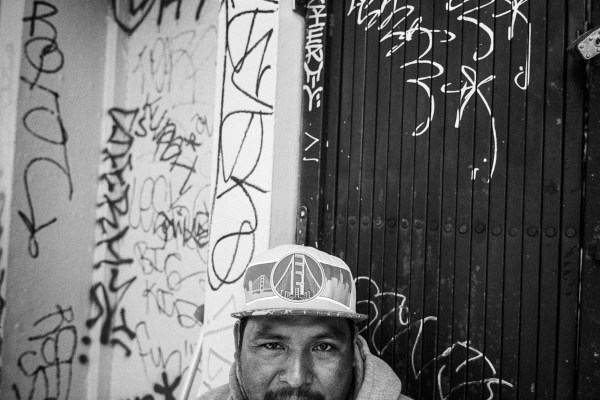Jacento B. sits quietly on a folding stool on Mission Street, his crutches leaned against the wall. A Giants cap rests on his lap, scattered with coins. A stranger hands him a warm bag of pupusas. He thanks them and tucks it into his black bag.
“I feel guilty doing this because I’m not used to this kind of life,” said Jacento, who otherwise had worked his whole life. “But sometimes the need forces you.”
Jacento came to San Francisco chasing steady work. He joined the ranks of the city’s day laborers: men who wait on street corners for painting, demolition or landscaping jobs. They are the unseen backbone of the city’s economy, taking on its most dangerous and least protected work.

“These are people who we know have experienced and continue to experience a lot of traumas,” said Ana Miguel, a program coordinator with Border Angels. Miguel says day laborers are rarely given proper training or safety equipment. “These are jobs that are not certified and a huge issue that we see a lot of times is the issue of wage theft, too.”
The fragile stability of these informal gigs collapsed for Jacento in October 2022. He had taken an under-the-table moving job for $200. While loading a truck, a heavy machine fell on him, crushing his left leg and the phone in his pocket. “I remember them telling me ‘don’t go to sleep, don’t go to sleep.’” He barely survived.
According to researcher César Leonardo Pinzón Gómez of The Center for Health Promotion and Prevention, many Latin American people migrate for better job opportunities and safer working conditions but arrive to “a different set of stressors.”



For Jacento, those pressures began in Guatemala. His parents were displaced during the country’s 36-year civil war, when the government seized their land. After the 1996 Peace Accords, the family received a small plot from the European Union and started a coffee farm in Chimaltenango. Jacento worked alongside his father from age 10, growing most of their own food and attending school with help from a small inheritance from his grandfather.
But in Guatemala, education rarely guarantees decent-paying work. By his twenties, Jacento was taking whatever jobs he could in markets and on farms, earning around $130 a month. “We always wanted to have a house, to buy a car. So fighting for a better life in Guatemala was difficult.”
In 2019, he told his family he needed to leave. His younger brother had already migrated to Chicago but was detained by Immigration and Customs Enforcement and deported. “What finally pushed me to leave was my problem with alcoholism,” Jacento said. “I just needed a change for myself and to learn new trades.”
He arrived in the Bay Area with few contacts but quickly found work, first as a gardener, then in moving and construction. At his best, he could make $400 a day, with tips included , but the jobs were unstable. COVID wiped out his steady hours, and by 2022 he was working off the books for a large construction firm at $25 an hour. When his wages dropped after taxes, he went back to day labor.


Two weeks later, a former roommate asked for help moving heavy equipment. That day, a three-ton machine fell on him inside a rented pickup truck. To this day, he still can’t recall what kind of machine it was, only its weight, and the damage it caused. “How could this machine crush my entire leg bones, but not my chest? God was extraordinary. I am still alive,” he said.
After the accident, Medi-Cal covered some costs, but he said anesthesia and amputations were not fully covered, leaving him with $60,000 in medical bills. “It’s a new life that I have now, I’m just grateful to be alive and have the support from my family.”
This year brought more loss: in July, his father died unexpectedly in Guatemala. Now, Jacento sometimes panhandles on Mission Street to help his brother pay rent and cover basic needs. His goals remain to attend physical therapy, adapt to his prosthetic and work again.



More on day laborers
- ICE fears and loss of work hit San Francisco’s day laborers hard
- How immigrants can protect themselves from wage theft in California
- Op-Ed: Five ways to defend San Francisco’s immigrant day laborers
His injury is both a personal tragedy and a warning. In a city built on immigrant labor, a single misstep on a ladder or faulty power tool can end not just a career, but someone’s overall livelihood. Advocates say that without stronger workplace safety enforcement and legal protections, more workers will face the same fate as Jacento. Meanwhile, community groups like Nuevo Sol Day Labor & Domestic Worker Center are pushing for reforms that could save lives.
“My father taught us how to work and be resilient from the coffee farm,” said Jacento. “I know this is going to be very difficult, but I am going to walk again. I have to keep going.”




